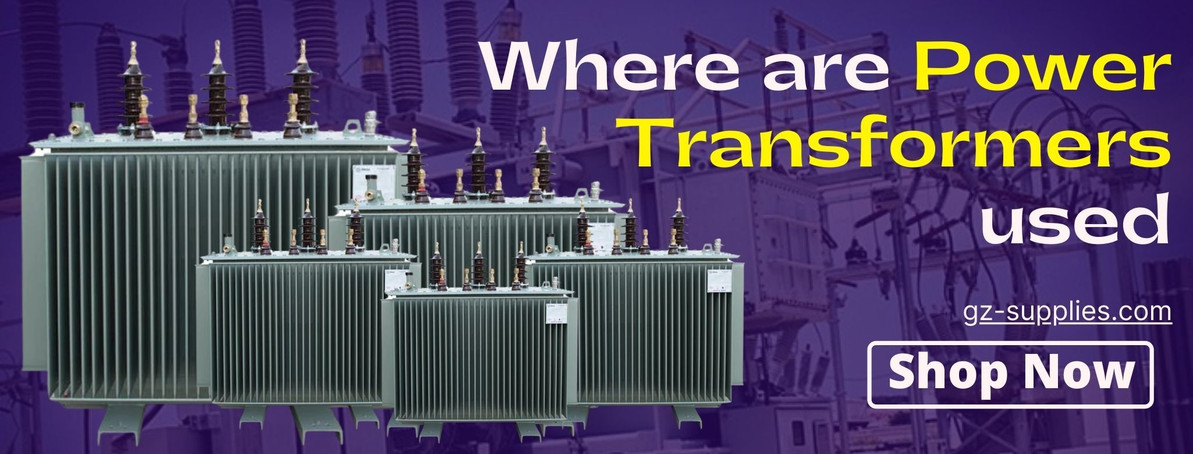Where are Power Transformers used?
Transformers are designed to grant the reliability, durability, and efficiency required in utility, industrial, and commercial applications. Transformers are important components in our current life and they make large power systems possible. To effectively transfer hundreds of megawatts of power over long distances, very high line voltages are required – in the range of 161 to 1000 kV.
What is a Transformer
A transformer is a passive electrical device designed to transfer alternating current (AC) from one electrical circuit to another, usually by the principle of mutual induction. During this process, the frequency remains constant whereas the voltage can be increased or decreased according to the need. Transformers that increase voltage between the primary to secondary windings are defined as a step up transformer and a transformer that decreases voltage between the primary to secondary windings is defined as a step down transformer. Whether the transformer increases or decreases the voltage level depends on the relative number of turns between the primary and secondary side of the transformer.
Transformers are completely static and can not be moved because of their solid state. It is durable and can last for a long period without developing fault under normal operating conditions. Without transformers, it would be impossible to develop large power systems that exist today. Transformers can be categorized in different types and ways, depending on their purpose, use, construction etc, which one of them is Power Transformer.
Power Transformer
A Power Transformer is designed to handle high voltage inputs and can operate at 100% efficiency (as compared to 60-70% efficiency for other transformers). Usually, power transformers handle high voltage in utility transmission networks at the range of (400 kV, 200 kV, 110 kV, 66 kV, 33kV) either for step up or step down applications and are normally rated higher than 200MVA.
Additionally, power transformers enable power to travel longer distances effectively without loss of power. In this way, step-up transformers help in supplying power to transmission lines, though end users are not to use these power transformers because of its high voltage. Such high power will not only damage the appliances, but can also cause hazards and death. This is why the voltage needs to be decreased again before being sent to the end customers. Step-down transformers are therefore used at substations.
If the power transformer is connected in the transmission network, the load fluctuation will be very less as they are not connected at the consumer end directly, but if connected to the distribution network there will be fluctuations in the load.
Features of Power transformers
- power transformers support a wide range of voltage levels with applications in generation, transmission and distribution
- The power transformer is cost-effective: the use of rigid and precise materials in the power transformers ensures low losses in the magnetic core and even in the windings which results in the reduction of operating costs.
- The transformer is used to control the fluctuation of high or low voltages and it is reliable because of its advanced technology incorporated in the manufacturing process of windings.
- Power transformers have more than one primary and secondary windings, It can be configured as either a single-phase primary configuration or a three-phase configuration.
- Maximum Safety- All the power transformers are carried out through the cooling by means of air and without any insulation.
Classifications of Power Transformers
Power transformers cover the population of the largest transformer units by means of power and voltage ratings. There are several different classifications of power transformers according to their power and voltage ratings or size, and/or according to the application.
Power transformers can be classified into three types based on the ranges. They are large power transformers, medium power transformers and small power transformers.
Small Power Transformers (SPT)
Small Power Transformers (SPT) Transformers range from 500-7500kVA.
Medium Power Transformer (MPT)
Medium Power Transformers (MPT) This group includes transformers with a power range from 7500-100MVA
Large Power Transformer (LPT)
This group covers the largest units in the power transformers population with power of normally range from 100-200 MVA and above
Where are power transformers used.
Electrical power is one of the major elements of our everyday life that we rely on and we cannot imagine a lifestyle without electrical energy/electricity. Like we mentioned earlier, they are used in a transmission network to step up or down the voltage levels.
The Power transformers are used in many applications like :
- Measurements( as voltage and current transformers ).
- Control circuits ( step down to feed circuits with low voltage as 24 , 12 VAC).
- Power transformers in substations before transmission to large industrial consumers. ( step up ).
- Power distribution ( Step down from medium voltage to low voltage )
- Power transformers are used in the industry
- Power transformers are used on platforms, marine vessels and under the sea.
- Power transformers are used in every power plant and buildings.
Power transformers cover the highest power and voltage ratings within the transformers family. Their lifespan is around 30 years of service when operated within its rating.
Contact GZ industrial supplies for power transformers. GZ Industrial Supplies is the supplier and distributor of Power Transformer in Nigeria. We have a complete range of copper power transformers designed to grant the reliability, durability, and efficiency required in utility, industrial, and commercial applications. Our power transformers are designed and manufactured to the highest quality standards to ensure enduring reliability.
Recent Posts
-
Top 10 Industrial Hubs in Nigeria: A Guide for Suppliers and Manufacturers
Introduction Nigeria, Africa's largest economy, boasts a diverse and rapidly growing industrial …Apr 10, 2025 -
What is the Difference Between 11KV and 33KV Power Transformer Lines?
Introduction As an electrical engineer or utility professional, you likely handle a variet …Apr 10, 2025 -
Which Generator is Best for Home use in Nigeria 2025
Unstable power supply is a reality many Nigerian households contend with daily. Whether it&rsqu …Apr 09, 2025





